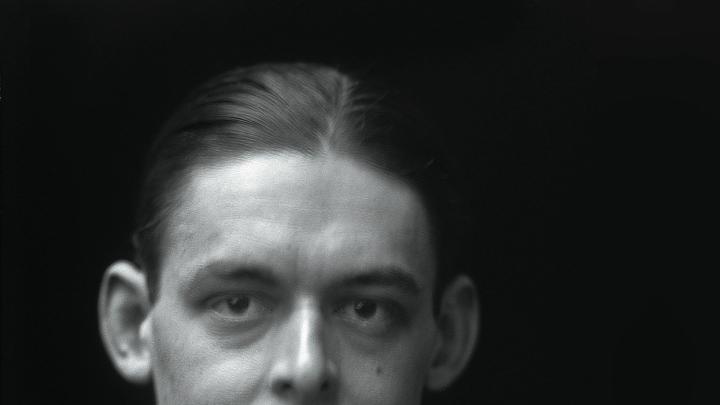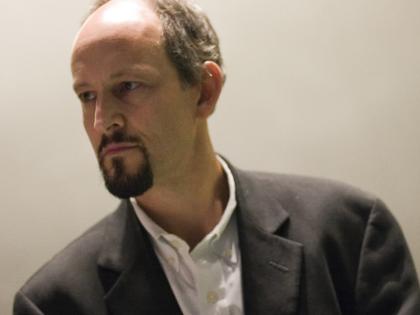If it is true that the child is father to the man, then no poet disavowed his paternity as successfully as T.S. Eliot ’10, A.M. ’11, Litt.D. ’47. Looking at the severe, bespectacled face of the elderly poet on the cover of his Complete Poems and Plays, it is hard to imagine that he was ever young. By the time he died in 1965, Eliot had achieved a position of almost papal authority in the world of literature, confirmed by the award of the Nobel Prize in 1948. Generations of readers grew up revering not just his broken, haunting poetry, but his magisterial criticism, in which he revolutionized the canon of English poetry with serene confidence.
In a sense, the role of “the elder statesman”—the title of one of his verse plays—was one for which Eliot had been rehearsing his whole life. His first great poem, “The Love Song of J. Alfred Prufrock,” was written mostly in 1911, when he was 22 years old, yet it is preoccupied with debility: “I grow old...I grow old.../I shall wear the bottoms of my trousers rolled.” He would assume the same tone eight years later, when he wrote “Gerontion” in the voice of “an old man in a dry month...an old man,/a dull head among windy spaces.” And it was with an air of final resignation that he began “Ash-Wednesday,” asking, “Why should the aged eagle stretch its wings?” He was still 41, but it is clear that old age was not a chronological matter for Eliot. It was the condition of his imagination, a name for the attenuation of passion which he simultaneously dreaded and desired.
For many years, the young, American Eliot was effectively erased by the imposing image the adult, British Eliot created. “It is the final perfection, the consummation of an American,” he wrote in an essay on his fellow expatriate Henry James, “to become not, an Englishman, but a European—something which no born European, no person of any European nationality, can become.” In turning himself into such a European, Eliot buried his Americanness deep enough that it takes some digging to recognize it. Matters weren’t helped by the long delay of the Eliot estate—controlled by the poet’s second wife and widow, Valerie Eliot—in publishing his full correspondence, as well as his voluminous uncollected prose.
Although Eliot remains absolutely central to the history of modern poetry, his personal authority inevitably declined in the years after his death, in tandem with changes in taste and critical method. The issue of his anti-Semitism, while never a secret—the anti-Jewish passages in his poetry are quite overt—also helped to cloud his reputation, when given renewed attention by scholars like Anthony Julius. With much of his criticism out of print, and biographers given only limited access and permission to quote from his writing, by the end of the twentieth century Eliot had become a blurrier figure than would once have seemed possible.
In the last few years, however, all that has changed dramatically. Before her death in 2012, Valerie Eliot helped to prepare a full new edition of Eliot’s letters, edited by Hugh Haughton and John Haffenden, which has been appearing at a steady clip. (Five volumes are now in print, covering the period 1898 to 1931.) Last year, a second major Eliot edition began publication: his Complete Prose, edited by Ronald Schuchard. The first two volumes of this digital-only series include Eliot’s surviving writing from high school and college, as well as the work that made him famous as a critic in the late 1910s and early 1920s—essays like “Tradition and the Individual Talent” and “The Metaphysical Poets.” And this spring, Robert Crawford published Young Eliot, the first volume of a new biography that far surpasses all its predecessors in the depth and range of its familiarity with Eliot’s world.
The result is that even though the youthful Eliot remains an elusive presence, we can get closer to him than ever before. In particular, the flood of new Eliot material helps to make clear how important the poet’s time at Harvard was to his development. Indeed, of all the American poets who studied at Harvard—and the list is a long one, including writers as various as Robert Frost ’01, Litt.D. ’37, and John Ashbery ’49, Litt.D. ’01—it’s possible that none was shaped by the College more deeply than Eliot, the greatest of all. From the fall of 1906 until the spring of 1914, Eliot spent every academic year but one as a Harvard student, first as a surprisingly indifferent undergraduate, then as a budding philosopher in the graduate school. These were the years in which Eliot discovered his vocation, wrote his first mature poems—including “Prufrock”—and imbibed the wide-ranging texts and ideas that would fuel his work for years to come.
Indeed, the famous eclecticism of “The Waste Land,” which incorporates quotations from multiple languages and literatures, can be seen as a tribute to the educational philosophy that governed Harvard during Eliot’s time there. Under the presidency of his distant relative Charles William Eliot, the College had introduced an elective system that gave students wide leeway in choosing their own classes from a variety of subjects and departments. Later in life, Eliot lamented this undergraduate freedom: “I was one of the victims of the ‘elective system,’” he wrote in a letter to his mother. He had been “so interested in many things that I did nothing thoroughly, and was always thinking about new subjects that I wanted to study, instead of following out any one.”
Yet as Crawford shows in the impressively researched Young Eliot, the “melange of topics” that Eliot explored in college “mightily enriched his poetry.” Eliot’s studies with the philosopher George Santayana planted the seeds of the idea that later emerged in his criticism as the “objective correlative”—the notion that poetic images function as a formula to evoke an emotion. In the recently founded Comparative Literature department, Eliot studied with scholars who “encouraged people...to connect literary works through anthropology to supposedly primitive rituals.” This would become a major technique of “The Waste Land,” which uses the Grail legend, as interpreted by scholars like James Frazer and Jessie Weston, as a structuring myth.
Crawford even manages to track down the moments when Eliot first discovered images and individual words he would later employ in his verse. As a junior, for instance, he took a class on the Roman novel that included Petronius’s Satyricon; years later, the novel’s image of an undying Sibyl appeared in the epigraph of “The Waste Land.” In Eliot’s own annotated copy of the novel, which Crawford examines, the poet glossed the Latin word for mushrooms, tubere in the text—a word that returns in “The Waste Land,” where he writes of winter “Feeding/a little life on dried tubers.” There is something thrilling about the way Crawford locates such moments in time and space, showing how a poem as mysterious and complex as “The Waste Land” draws on something as familiar as a college syllabus.
The magpie erudition of Eliot’s work can intimidate readers, giving the sense that all of European literature (and some Indian literature, too) lies at his fingertips. This was an illusion; his real scholarly expertise was limited to philosophy, a subject that entered his work only in indirect and subtle ways. When it came to Dante, or the Elizabethan drama, or ancient Greek and Latin, what Eliot had was not a scholar’s easy mastery but a poet’s instinctive ability to find what he needed. Even so, it is surprising to find that Eliot was, especially at first, an unusually poor student. Indeed, as Crawford writes, “by today’s standards, it is surprising that Thomas Stearns Eliot was admitted to Harvard.” His high-school grades were unimpressive enough that he had to take an extra year of study at Milton Academy to make up on the subjects he had missed back home in St. Louis. And in his first semester, he earned Ds in almost every course, including Greek B, German A, and Government 1. The assistant dean had to write to his parents, warning them that he could flunk out.
In time Eliot would take his studies more seriously. In the Collected Prose, it’s possible to read one of his few surviving undergraduate papers, an essay for English 12 titled “The Defects of Kipling,” in which the mature Eliot’s tone of critical certainty is already audible: “Nothing is so pathetic in literature as the immaturity which the practiced brain cannot shake off, nor the practiced hand conceal,” he pronounces. (The paper earned a B+.) But for all he learned in the classroom, it was his private, extracurricular reading that had the biggest influence on his intellectual and poetic development. He arrived at Harvard already a writer and a poet, and published in the Advocate in his freshman year. But his work was still itself “immature,” with few signs of the poet to come.
At this stage, the most notable and lively verse Eliot produced was the obscene doggerel he turned out for the delight of his fellow members of the Digamma Club (later renamed the Fox Club). Here he invented the characters of “Columbo” and “Bolo,” who for years to come starred in a series of scatological, violent, and racist poems. Circulated privately, these verses became known to a wider readership only after Eliot’s death, when they presented the immensely refined poet in a bizarrely crude light. As Crawford writes, however, such writing served a purpose for the shy, physically awkward, and sexually late-blooming Eliot. It was a way for him to bond with his peers in “a predominantly male milieu with marked strains of anti-Semitism, sexism and racial prejudice.”
A totally different side of Eliot’s imagination came to life at the end of 1908, when he was browsing in the Union Library—a collection of books housed in the old Harvard Union (now the Barker Center). Here he came across The Symbolist Movement in Literature, by Arthur Symons, a recent book of literary criticism that offered an introduction to avant-garde French poetry. “The Symons book is one of those which have affected the course of my life,” Eliot would recall later. In particular, he was thunderstruck by the lines he read from Jules Laforgue, the sophisticated, neurasthenic, ironical French poet, who was just 27 years old when he died in 1887. Burning to read more and finding that the Harvard libraries did not own Laforgue’s collected works, Eliot immediately sent away to Paris for them.
Reading Laforgue turned out to be the catalyst for Eliot’s growth into a genuine poet. While he was still capable of writing pretty, conventional verses like those he produced for the Class Ode at his 1910 graduation, in his most personal work he was now trying on Laforguean gestures, rhetoric, and vocabulary. His notebook for these years, published decades after his death under the title Inventions of the March Hare, is full of Laforguean titles and parodies. And in 1911, when he visited Paris and Munich during a year of study abroad, Eliot would go beyond imitation to produce, in “Prufrock,” a poem that thoroughly absorbed Laforgue and transcended him. Out of that encounter in the Union library had emerged one of the first modernist masterpieces in English.
Eliot returned from Europe as a 23-year-old who was already one of the best poets in America, though no one yet knew it. Instead, he settled into the studious life of a Ph.D. candidate, living in lodgings at 16 Ash Street. He took up the study of Sanskrit, which would pay dividends later when he came to write “The Waste Land,” while also mastering Aristotle in Greek and coming to grips with the contemporary philosopher F.H. Bradley, who was the subject of his dissertation. Eliot even had time to participate in amateur theatricals with Cambridge neighbors, once appearing on stage alongside the young E.E. Cummings ’15.
Nothing about Eliot’s relationship with Harvard was more important, however, than its abrupt end. In 1914, the 25-year-old poet went to Oxford on a fellowship, intending to study for a year or two and return to complete his degree. A job teaching at Harvard was likely to be in his future. His connection with home became tenuous even before he arrived, when the outbreak of World War I made traveling back across the Atlantic a dangerous proposition. But Eliot himself took care to cut the cord—with his family, with Harvard, and with the life that he was supposed to lead—in more dramatically personal fashion. In June 1915, he impulsively married a woman he had known for only a few months, Vivienne Haigh-Wood. Decades later, after a legendarily disastrous marriage that ended with Vivienne’s commitment to an asylum (and inspired some of Eliot’s best poetry), he mused on his true motives: “I think that all I wanted of Vivienne was a flirtation or a mild affair: I was too shy and unpractised to achieve either with anybody. I believe I came to persuade myself that I was in love with her simply because I wanted to burn my boats and commit myself to staying in England.”
Here, if ever in Eliot’s life, was what he described in “The Waste Land” as “The awful daring of a moment’s surrender/Which an age of prudence can never retract.” But as the poem goes on to acknowledge, “By this, and this only, we have existed.” And it is clear that the man Eliot became—the British citizen and member of the Church of England, the poet of the international metropolis, the critic who defined and defended the European mind—could never have existed had he returned to America. Like Paul Gauguin abandoning France for Tahiti, Eliot was rolling the dice of his future, not knowing whether his gamble would pay off.
Certainly his most distinguished Harvard relative found it hard to understand what he was up to. The poet had finished and submitted his dissertation, but instead of returning to defend it and formally take his degree, he kept offering excuses and delays. Calling him to order, President Eliot wondered how “you or any other young American scholar can forgo the privilege of living in the genuine American atmosphere—a bright atmosphere of freedom and hope.” There is some impatience here, at a favored student who turned his back on Harvard’s largesse, but there is also true bewilderment. With Europe devastated by the Great War, while America was poised for a decade of unprecedented prosperity, it might well have seemed perverse to choose London over Cambridge, Massachusetts. However provincial the latter appeared by contrast, it had served as Eliot’s muse before, as in the early, unpublished poem “Second Caprice in North Cambridge”:
The charm of vacant lots!
The helpless fields that lie
Sinister, sterile and blind—
Entreat the eye and rack the mind,
Demand your pity.
With ashes and tins in piles,
Shattered bricks and tiles
And the débris of a city.
Lines like these suggest that the vision of urban chaos and decay which Eliot was to perfect in “The Waste Land,” with its apotheosis of the “Unreal City,” had its origins in the more modest setting of working-class Cambridge. To Eliot in England, however, the town represented a life of academic, bourgeois respectability that he instinctively fled, as he explained to his friend and fellow-student, the poet Conrad Aiken ’11: “I dread returning to Cambridge…and the people in Cambridge whom one fights against and who absorb one all the same. The great need is to know one’s own mind, and I don’t know that: whether I want to get married, and have a family, and live in America all my life, and compromise and conceal my opinions and forfeit my independence for the sake of my children’s future….” Here he seems to echo his fellow actor Cummings, who in a famous poem of his own railed against “Cambridge ladies who live in furnished souls.”
It’s hard to resist wondering what would have happened to T.S. Eliot if, in that fateful summer of 1915, he had chosen Harvard and America over marriage and England. Would he have settled into a professorial life and stopped writing poetry, as he seemed to fear? Or might he have been energized by the modernist renaissance of American letters in the 1920s, becoming a friend and colleague of poets like Wallace Stevens and William Carlos Williams? Could Eliot have flourished in a “bright atmosphere of freedom and hope,” or did he need the alienation and pessimism of wartime London to fertilize his genius?
One thing is certain—an Eliot who stayed home, who fit into America instead of rejecting it, would never have produced a poem as apocalyptic and magisterial as “The Waste Land.” Perhaps T.S. Eliot needed to escape Harvard in order to make use of everything he had learned there.








